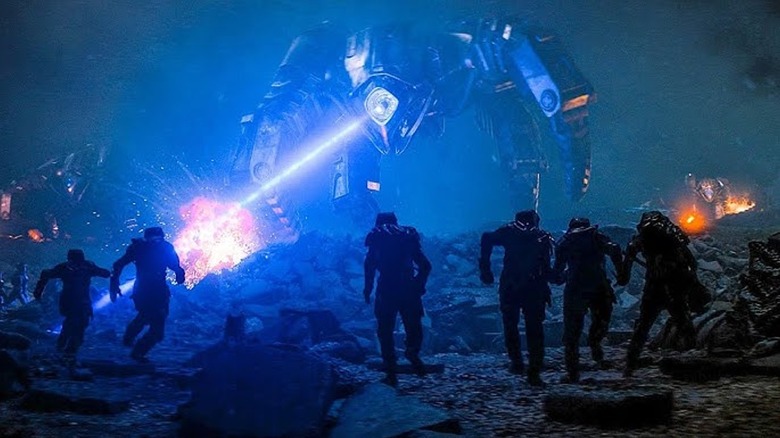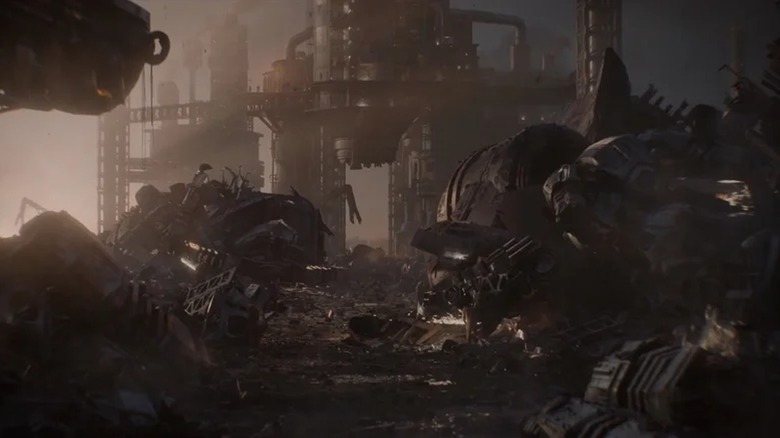This post contains spoilers for Frank Herbert's Dune series of novels.
The rise and fall of Paul Atreides may be the heart of the Dune saga, but Frank Herbert's painstakingly rich, vivid world-building eclipses its protagonists. Change is constant in the Dune universe, where events span distant planets and galaxies; where emperors, messiahs, tyrants and shadow powers take turns shaping the uncertain future. About 10,000 years before the events of Dune, a war was waged against the technocratic class and their "thinking machines", which completely destroyed (and erased) their heritage and rebuilt society from the ground up. This campaign of extermination that led to computers and artificial intelligence being banned forever from the known universe became known as Butler's Jihad, or The Great Revolt, seen in HBO's Dune: Prophecy.
It is crucial to distinguish the prohibited machines in Dune from our common understanding of the term. The term "thinking machine" has been used to describe any form of artificial intelligence with sentience and autonomy, be it in the form of supercomputers or sentient robots. The rise of these thinking machines was inevitable with the level of technological advancement that has flourished throughout the known universebut machine intelligence soon took on oppressive forms that were harmful to humanity itself. Humanity's response to this pervasive technocracy was religious fanaticism (hence the term "jihad") because spiritual faith was seen as antithetical to cold machine logic. While Frank Herbert's original series of novels dealt only with Butler's Jihad, Brian Herbert and Kevin J. Anderson explored it further in Dune: The Butler's Jihad, which is considered part of the series' expanded universe.
Let's first take a look at Frank Herbert's research on the Great Revolt, then move on to what the expanded universe has to say about this historical event set in the world of Dune.
Why did humanity rebel against the thinking machines in Dune
"Once upon a time, humans outsourced their thinking to machines in the hope that it would liberate them.
This quote from "Dine" sums up the catalyst of the Great Rebellion, which insisted that humanity set its own guidelines to remake the world (something machines were believed to be incapable of, despite their sentience). What began as justifiable resentment quickly escalated into a religiously fueled hysteria that fueled an indiscriminate hatred of all things mechanical in nature. With the complete eradication of technology, human civilization underwent an upheaval, creating a void that needed to be filled by something that relied entirely on human intelligence.
By 108 BG (Before the Guild), the mental order was created to deal with this void. Mentat was a discipline developed specifically to replace machine intelligence, and humans who demonstrated the cognitive capacity to think on par with computers were given this title. For example, Tufir Hawat, who loyally served the Atreides centuries laterproved necessary for his mental abilities, which were equivalent to those of a supercomputer. Along with the Mentats, the all-female Bene Gesserit and the Spacing Guild of Navigators were founded to prevent civilization from regressing to its primitive state. But were these organizations enough to fill the gaps left by the machines?
This question was partially answered by the rise of the new political system, with the Emperor Padisha of House Corino acting as executor of the feudal galactic order supported by the Great House and key organizations (including the Bene Gesserit). This system lasted for thousands of years until Paul Atreides crowned himself emperor in 10196 and started another violent holy war.
What the Dune Expanded Universe Says About The Great Rebellion
The Dune Expanded Universe, along with portions of The Dune Encyclopedia (which includes a foreword by Frank Herbert himself), trace the "Butler" etymology back to Manion Butler the Innocent, whose death was the catalyst for the Great Rebellion. Long story short, an independent robot named Erasmus killed the infant Manion to get the attention of his mother, Serena, by throwing the child off the top of a tower. Serena, in her rage-fueled desperation, destroyed a thinking machine guardian in revenge, and the cruelty of this child-killing sparked an uprising that eventually led to a holy war against the machines. Soon after, Mannion was declared a spiritual martyr, and a religious cult was born around Serena, further fueling a newfound obsession with faith and religion.
Serena's fury became the face of the rebellion, gaining the support of people who until this point had been subjugated by robots like Erasmus. In retaliation, the thinking machines, which were led by Omnius Prime—the title held by the most powerful AI entities among the Omnius—unleashed a plague that wiped out billions of people. These events took place on a rapidly declining Earthwhich was on the verge of becoming habitable as the war continued to rage. After the Earth became completely irradiated due to atomic war and natural disasters, the Battle of Korin (fought on the planet Korin) appeared as a turning point that helped wipe out the thinking machines once and for all.
Although Frank Herbert used brief references to the Great Rebellion to emphasize themes of cyclical oppression, the expanded universe helps fill in the gaps to draw deeper parallels between machine warfare and the holy war Paul waged centuries later. While few Dune adaptations have tackled machine warfare directly, it's a narrative thread worth repeating time and time again.
Source link



